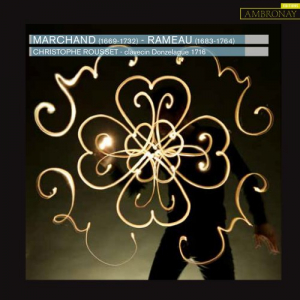Christophe Rousset - Marchand & Rameau: Å’uvres pour clavecin '2012
24bit

| Artist | Christophe Rousset Related artists |
| Album name | Marchand & Rameau: Å’uvres pour clavecin |
| Country | |
| Date | 2012 |
| Genre | Classical Harpsichord |
| Play time | 00:58:25 |
| Format / Bitrate | 24 BIT Stereo 2429 Kbps / 96 kHz |
| Media | WEB |
| Size | 437 mb / 1.25 gb |
| Price | Download $8.95 |
Order this album and it will be available for purchase and further download within 12 hours
Pre-order album Tracks list
Tracks list
Tracklist 01. Suite en Ré, premier livre: I. Prélude 02. Suite en Ré, premier livre: II. Allemande 03. Suite en Ré, premier livre: III. Courante I 04. Suite en Ré, premier livre: IV. Courante II 05. Suite en Ré, premier livre: V. Sarabande 06. Suite en Ré, premier livre: VI. Gigue 07. Suite en Ré, premier livre: VII. Chaconne 08. Suite en Ré, premier livre: VIII. Gavotte 09. Suite en Ré, premier livre: IX. Menuet 10. Suite en Sol, deuxième livre: I. Prélude 11. Suite en Sol, deuxième livre: II. Allemande 12. Suite en Sol, deuxième livre: III. Courante 13. Suite en Sol, deuxième livre: IV. Sarabande 14. Suite en Sol, deuxième livre: V. Gigue 15. Suite en Sol, deuxième livre: VI. Gavotte 16. Suite en Sol, deuxième livre: VII. Menuet I 17. Suite en Sol, deuxième livre: VIII. Menuet II 18. Trois pièces: I. Vénitienne 19. Trois pièces: II. La badine 20. Trois pièces: III. Gavotte 21. Suite en La, premier livre: I. Prélude 22. Suite en La, premier livre: II. Allemande I 23. Suite en La, premier livre: III. Allemande II 24. Suite en La, premier livre: IV. Courante 25. Suite en La, premier livre: V. Gigue 26. Suite en La, premier livre: VI. Sarabande I 27. Suite en La, premier livre: VII. Sarabande II 28. Suite en La, premier livre: VIII. Vénitienne 29. Suite en La, premier livre: IX. Gavotte 30. Suite en La, premier livre: X. Menuet Louis Marchand is the French composer who has entered legend for a musical duel with J. S. Bach which he is supposed finally to have dodged. But to make one’s mark on posterity that way is a sad comedown for so eminent a composer of organ and harpsichord music. Although he died in the reign of Louis XV, he retained in his style a nobility of tone wholly typical of the age of Louis XIV. The conception of harpsichord sound in Marchand is much closer to d’Anglebert than to Rameau. Like his predecessor, he employs a profusion of ornaments which considerably enrich the sustaining power of the sound and mean that a string is kept constantly in vibration. He uses the medium-low register in preference to the treble, thus bringing the harpsichord closer to the theorbo or the bass viol. Rameau, for his part, immediately imposes his new and revolutionary conception of music. Everything here breathes harmony. The discourse is always deliberately clear, favouring transparency over the bombastic effects of a more sensual harpsichord sound. The link that inspired me to choose this programme for the sumptuous Donzelague harpsichord, which, it may be recalled, was only just saved for the nation when I was still a student with Huguette Dreyfus (I can still remember the inaugural concert at the Salle Gaveau where my teacher played Rameau on it, among others) is, of course the city of Lyon. Donzelague built his instruments in Lyon; Marchand was born and studied the organ with his father there. Rameau lived in Lyon for a period in 1713, composing his grands motets there. During his brief stay in Paris in 1706, he took up residence opposite the Church of the Cordeliers where Marchand just happened to be organist at the time, and attempted to solicit the favour of the Parisian public by publishing his first opus at so early an age. This Donzelague harpsichord, like the instruments by Nicolas Dumont from the early years of the 18nth century, is extended down to the low F, thus abandoning the 17th-century French tradition of the G’-B short octave. Hence it allows the music on the present recording to sound in its full sonic and declamatory amplitude.
Related artists
Christophe Rousset
Album
- 2017 Balbastre: Pieces De Clavecin, Livre I [2]
- 2012 Marchand & Rameau: Å’uvres pour clavecin
- 2010 Bach: Fantasy
- 2009 Rameau: Les Indes Galantes
- 2003 Bach: Suites anglaises
- 1998 Domenico Scarlatti: 15 Harpsichord Sonatas
- 1995 Gaspard Le Roux: Pièces de clavecin
